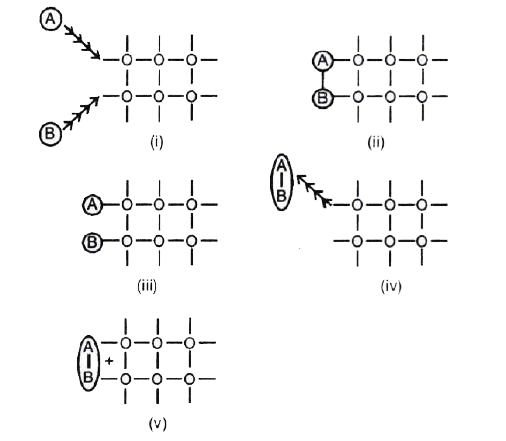Arrange the following diagrams in correct sequence of steps involved in the mechanism of catalysis, in accordance with modern adsorption theory.

A
(i) (ii) (iii) (iv) (v)
B
(i) (iii) (ii) (iv) (v)
C
(i) (iii) (ii) (v) (iv)
D
(i) (ii) (iii) (v) (iv)
Text Solution
The correct Answer is:B
(i) Reacting molecules approach the surface of catalyst.
(ii) Reactant moleccules get adsorbed on the surface of catalyst.
(iii) Reactant molecules form an intermediate
|
Topper's Solved these Questions
- SURFACE CHEMISTRY BOOK - KALYANI PUBLICATIONCHAPTER - SURFACE CHEMISTRY EXERCISE - EXERCISE (PART-I ( OBJECTIVE QUESTIONS )) (Match the following :)
1 Videos
- SURFACE CHEMISTRY BOOK - KALYANI PUBLICATIONCHAPTER - SURFACE CHEMISTRY EXERCISE - EXERCISE (PART-II ( DESCRIPTIVE QUESTIONS )) (VERY SHORT ANSWER QUESTIONS)
31 Videos
- SURFACE CHEMISTRY BOOK - KALYANI PUBLICATIONCHAPTER - SURFACE CHEMISTRY EXERCISE - EXERCISE (PART-I ( OBJECTIVE QUESTIONS ))
31 Videos
- SOLID STATEBOOK - KALYANI PUBLICATIONCHAPTER - SOLID STATEEXERCISE - ISC EXAMINATION QUESTIONS PART-I (Numerical Problems)
5 Videos
Similar Questions
Knowledge Check
The correct sequence of steps involved in the mechanism of Cannizzaro reaction is
Anucleophilic attack, transfer of H− and transfer of H+Btransfer of H−, transfer of H+ and nucleophilic attackCtransfer of H+, nucleophilic attack and transfer of H−Delectrophilic attack by OH− , transfer of H+ and transfer of H−The correct sequence of steps involved in the mechanism of cannizzaro's reaction is……..
ANucleophilic attack, transfer of H− and transfer of H+BTransfer of H−, transfer of H+ and nucleophilic attackCTransfer of H+, nucleophilic attack and transfer of H−DElectrophilic attack by OH−, transfer of H+ and transfer of H−The correct sequence of steps involved in the mechanism of Cannizzaro's reaction is …..
Anucleophilic attack, transfer of H− and transfer of H+Btransfer of H−, transfer of H+ and nucleophilic attackCtransfer of H+, nucleophilic attack and transfer of H−Delectrophilic attack by OH−, transfer of H+ and transfer of H−.
Arrange the following steps in a sequence which are involved in the mechanism of dehydration of ethanol.
Formation of ethene by the elimination of a proton.
II. Formation of protonated alcohol.
III. Formation of carbocation.
View SolutionSelect the correct sequence of steps involved in PCR during gene amplification.
View SolutionWhich of the following kinds of catalysis can be explained by the adsorption theory?
View SolutionWhich of the following kinds of catalysis can be explained by the adsorption theory?
View SolutionWhich of the following kinds of catalysis can be explained by the adsorption theory ?
View Solution
